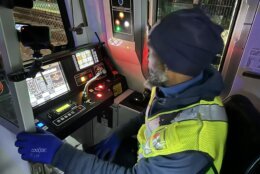This video is no longer available.
Citing improved safety and a better passenger experience, Metro officials are hoping to have Red Line trains operate in automatic mode starting later this month.
During an overnight demonstration this week, leaders described the impact of the move, which they say will result in an improved customer experience.
Even as trains operate in automatic mode, they still have an operator. While a computer starts and stops the trains along the line, the operator remains responsible for closing the doors and transitioning back into manual mode should circumstances warrant it.
Throughout the two-hour event on Monday, Metro touted the ease with which automatic trains can start and stop. They also detailed scenarios that may arise in real time and how operators should respond to them.
In one instance, once the train arrived at the Silver Spring station, central command alerted the operator of slippery conditions. For inclement weather or slippery conditions, operators have to function in manual mode, according to Amy Anderson, Metro’s supervisor for Rail Quality Training. Error messages or single-tracking would also prompt the operator to take over.
If the Washington Metrorail Safety Commission, Metro’s main watchdog agency, signs off the plan, the transit agency will begin automatic operation for the first time in 15 years. It paused those efforts after a deadly crash in 2009, though an investigation found the automatic operation wasn’t the cause of the incident.
“We can operate in a manual mode, or we can operate in an automatic mode,” said Tiffani Jenkins, Metro’s senior vice president of communication and signaling. “The failure that occurred was a failure of our protection system, not the mode that we’re operating in.”
Metro has tried to resume automatic operation several times since the crash, Jenkins said, but the effort takes a substantial amount of training, testing and infrastructure. Most of the agency’s operators have never experienced automation, so they’ve launched a training campaign to prepare them.








Within the last year, Metro has resumed automatic operation for doors opening, which has produced an 88% reliability data point, surpassing its goal of 80%, Jenkins said.
Once trains resume automatic operation, customers will experience a smoother ride as it stops and starts, which isn’t always the cause when a train is being manually operated, Jenkins said.
“This allows us to take it to another level of better scheduled trains, smoother rides, so customers will see more trains that could be there to provide even more reliable or timely service for them,” Jenkins said.
Because circumstances such as single-tracking do arise, Jenkins said “mixed-mode operations will be our norm.” If an operator feels uncomfortable because of a condition that pops up and wants to switch to manual mode, “that’s not an unsafe thing to do,” she said. Permission is required for operators to transition from manual to auto mode.
As for safety, Jenkins said Metro reviews every track circuit issue reported daily, multiple times a day. They’re also using a tool to prevent the issue Jenkins said caused the 2009 incident.
More information about Metro’s automatic operation plan is available online.
Get breaking news and daily headlines delivered to your email inbox by signing up here.
© 2024 WTOP. All Rights Reserved. This website is not intended for users located within the European Economic Area.








